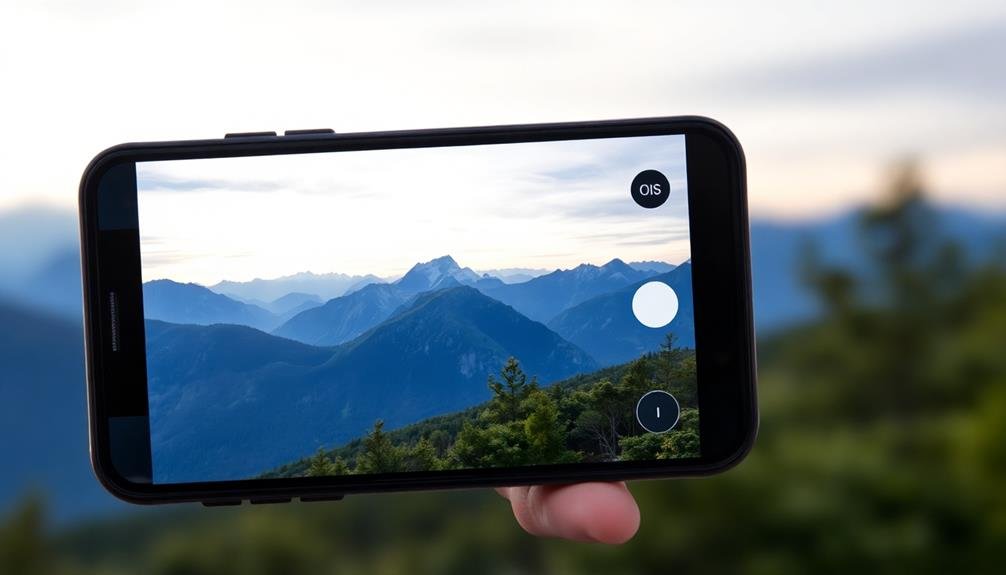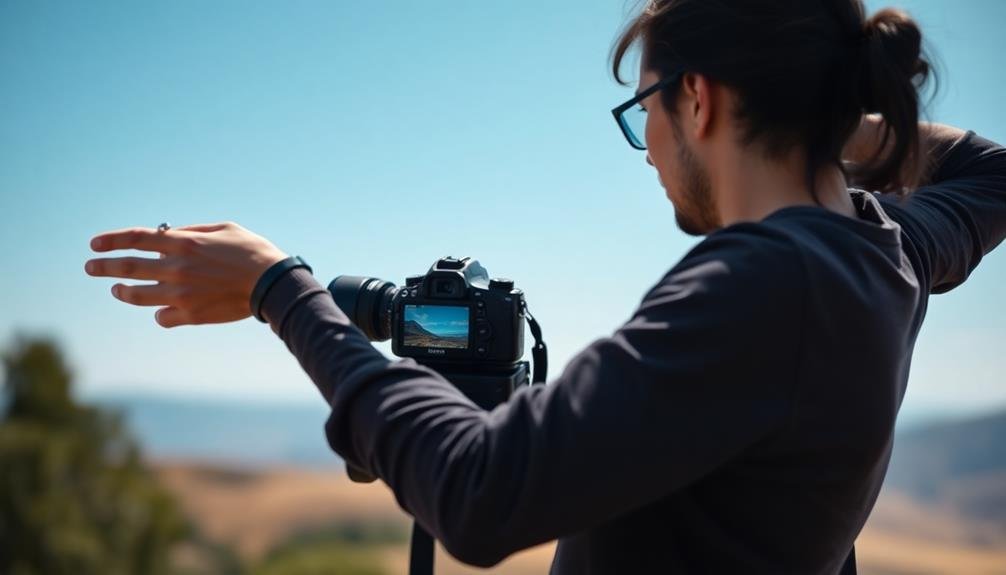To eliminate panorama motion blur, start by using a smartphone gimbal for enhanced stability. Enable optical image stabilization (OIS) if your device supports it, counteracting small hand movements. Maintain a consistent rotation speed while panning to avoid sudden jerks. Pivot from your hips, keeping your upper body still, to create a stable platform for sharper images. Finally, employ burst mode to capture multiple shots in rapid succession, increasing your chances of getting a crisp panorama. By mastering these techniques, you'll elevate your panoramic photography to new heights. Discover how each method can transform your shots from blurry to breathtaking.
Use a Smartphone Gimbal

Photographers know that stability is key when capturing panoramic shots. One of the most effective ways to achieve this stability is by using a smartphone gimbal. This handheld device helps eliminate motion blur by keeping your phone steady as you pan across the scene.
A gimbal uses motorized axes to counteract your hand movements, ensuring your phone stays level and smooth throughout the panorama capture process. You'll find that it's much easier to maintain a consistent horizon line and avoid vertical misalignments between frames.
When choosing a gimbal, look for one that's compatible with your smartphone model and offers panorama-specific features. Some gimbals have built-in panorama modes that automate the panning process, further reducing the risk of human error.
To use a gimbal effectively, mount your phone securely and calibrate the device according to the manufacturer's instructions. Practice smooth, slow movements as you pan, and consider using the gimbal's joystick control for even more precise motion.
Remember that while a gimbal considerably reduces motion blur, it's still important to pay attention to your technique and surroundings for the best results.
Enable Optical Image Stabilization

When it comes to reducing motion blur in panoramas, enabling Optical Image Stabilization (OIS) on your smartphone can make a notable difference. OIS uses tiny gyroscopes and motors to counteract small movements of your hand, resulting in sharper images.
To use this feature, first check if your smartphone has OIS capability, as it's typically found in mid-range to high-end devices.
If your phone has OIS, you'll want to verify it's activated before taking panoramic shots. Look for the OIS option in your camera app settings and toggle it on. Some phones automatically enable OIS for certain shooting modes, but it's best to confirm it's active for panoramas.
When shooting, hold your phone steady and move it slowly and smoothly. OIS will help compensate for minor shakes, but it can't correct for large movements.
Remember that OIS works best in conjunction with proper technique. As you pan, keep your elbows tucked in and use your whole body to rotate, rather than just your arms. This combination of OIS and proper form will notably reduce motion blur in your panoramic photos.
Maintain Consistent Rotation Speed

For achieving sharp panoramas, maintaining a consistent rotation speed is essential. As you pan your camera, aim for a smooth, steady motion without sudden jerks or pauses. This consistency helps your camera's software align and stitch the images together seamlessly.
Practice your panning technique before capturing the actual panorama. Start with a slower rotation speed and gradually increase it as you become more comfortable. Remember, it's better to move slowly and steadily than to rush and risk blurry shots.
Here's a comparison of rotation speeds and their effects:
| Speed | Pros | Cons |
|---|---|---|
| Very Slow | High detail, less blur | Time-consuming |
| Slow | Good balance | Slight risk of shake |
| Moderate | Efficient, natural feel | Potential minor blur |
| Fast | Quick capture | Increased blur risk |
| Very Fast | Exciting for action | High blur, stitching issues |
Use visual markers in your scene to help maintain a consistent speed. Focus on a distant object and move your camera at a steady pace, keeping the object in the same relative position in your viewfinder. With practice, you'll develop muscle memory for smooth, blur-free panoramas.
Pivot From Your Hips

After mastering a consistent rotation speed, it's time to focus on your body's movement. Pivoting from your hips is an essential technique to reduce motion blur in panoramic shots. Instead of turning your upper body or twisting at the waist, imagine your feet are planted firmly on the ground and your hips are the axis of rotation.
To execute this technique, stand with your feet shoulder-width apart and your weight evenly distributed. Keep your upper body, including your arms and camera, as still as possible relative to your torso. As you rotate, move your entire upper body as one unit, pivoting smoothly from the hips. This method minimizes unwanted vertical or horizontal shifts that can introduce blur.
Practice this movement without your camera first, then incorporate it into your shooting routine. You'll notice improved stability and consistency in your panoramas.
Remember to maintain a relaxed posture and breathe naturally throughout the process. By pivoting from your hips, you'll create a more stable platform for your camera, resulting in sharper, more professional-looking panoramic images with markedly reduced motion blur.
Employ Burst Mode Technique

In addition to mastering your body movement, employing burst mode can greatly reduce motion blur in panoramic photography. This technique involves taking multiple shots in rapid succession, increasing your chances of capturing sharp images. Most modern cameras and smartphones offer burst mode functionality, making it easily accessible for photographers of all levels.
To effectively use burst mode for panoramas:
- Set your camera to burst mode before starting the panoramic sweep.
- Begin your movement slightly before pressing the shutter button.
- Maintain a steady pace throughout the entire panoramic sequence.
- Continue the motion briefly after releasing the shutter.
By capturing a series of images in quick succession, you'll have more frames to choose from when stitching your panorama. This method helps compensate for small inconsistencies in your movement or unexpected environmental factors that might cause blur.
When selecting images for your final panorama, carefully review each frame from the burst sequence. Look for the sharpest and most well-aligned shots to guarantee a seamless final result.
While burst mode isn't a substitute for proper technique, it can considerably improve your chances of creating stunning, blur-free panoramic images.
Frequently Asked Questions
How Does Lighting Affect Panorama Motion Blur?
Lighting markedly impacts panorama motion blur. In low light, you'll need slower shutter speeds, increasing the risk of blur. Bright conditions allow faster shutter speeds, reducing motion blur. Consider using artificial lighting to maintain faster speeds.
Can Post-Processing Software Fix Motion Blur in Panoramic Images?
You can use post-processing software to reduce motion blur in panoramic images, but it's not a perfect solution. It's best to prevent blur during shooting, as software fixes may introduce artifacts or loss of detail.
What's the Ideal Shutter Speed for Capturing Blur-Free Panoramas?
For blur-free panoramas, you'll want to use a shutter speed of at least 1/125th of a second. If you're shooting handheld, aim for 1/250th or faster. In low light, use a tripod to maintain sharpness.
Are There Specific Tripod Features That Help Reduce Panorama Motion Blur?
Yes, there are! You'll want a tripod with a sturdy build, adjustable legs, and a smooth pan head. Look for features like bubble levels, quick-release plates, and a center column hook for added stability.
How Does the Camera's Sensor Size Impact Motion Blur in Panoramic Shots?
Your camera's sensor size affects motion blur in panoramas. Larger sensors generally perform better in low light, allowing faster shutter speeds. They also capture more detail, which can help mask slight motion blur in the final image.
In Summary
You've now got the tools to capture stunning panoramas without motion blur. Remember to use a gimbal, enable stabilization, and pivot smoothly from your hips. Keep your rotation speed consistent and try the burst mode technique for best results. With practice, you'll master these methods and create crisp, seamless panoramas every time. Don't be afraid to experiment and find what works best for you. Happy shooting!





Leave a Reply